
This is a general introduction to physics
 | This is a general introduction to physics |
| Metal | Melting Point | Boiling Point | Heat of Fusion | Hardness | |
| Lead | 327 | 1744 | 4.77 | 1.5 | - |
| Magnesium | 651 | 1107 | 8.95 | 2.0 | - |
| Copper | 1083 | 2595 | 13.05 | 2.5 | - |
| Nickel | 1453 | 2732 | 17.61 | - | - |
| Platinum | 1769 | 3827 | 19.66 | 4.3 | - |
| Iridium | 2410 | 4527 | 26.36 | 6.5 | - |
| Tungsten | 3410 | 5927 | 35.23 | - | - |
Pattern All of these increase together
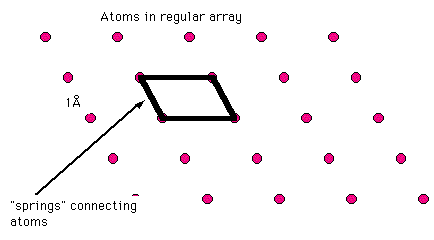
Heat ~ Energy
Predict : Elasticities will show similar variation
| Metal | Melting Point | Boiling Point | Heat of Fusion | Hardness | Elasticity |
| Lead | 327 | 1744 | 4.77 | 1.5 |
|
| Magnesium | 651 | 1107 | 8.95 | 2.0 |
|
| Copper | 1083 | 2595 | 13.05 | 2.5 |
|
| Nickel | 1453 | 2732 | 17.61 | - |
|
| Platinum | 1769 | 3827 | 19.66 | 4.3 |
|
| Iridium | 2410 | 4527 | 26.36 | 6.5 |
|
| Tungsten | 3410 | 5927 | 35.23 | - |
|
The logical flow should be:
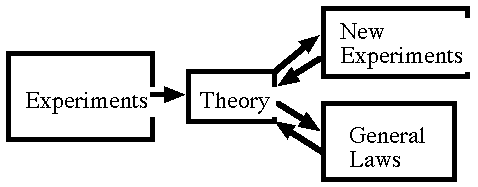
Given two theories, how do we choose between them? a) Find an experiment to distinguish them or b) Choose the simpler (???????) which is known as Occam's Razor
e.g. Aristotle
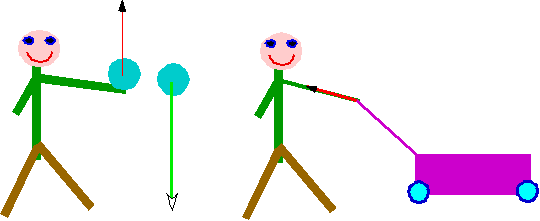
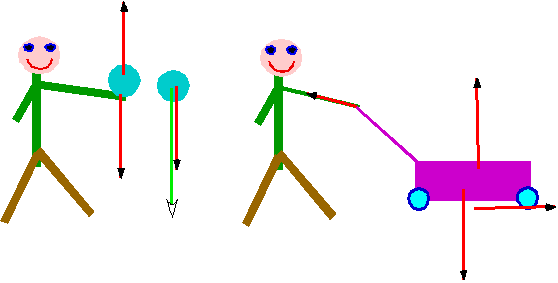 Theory makes more predictions
Theory makes more predictions
Life is Difficult (usually too difficult!)
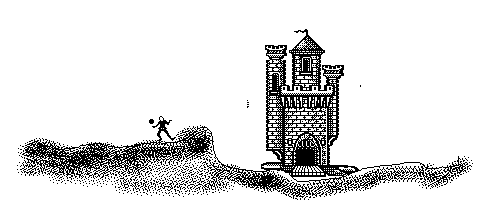 |
Ball will have air resistance, gravity will vary, sun and moon will attract ball, ball won't be a perfect sphere................. |
 |
Note that the world has become an infinite flat plain,we have ignored air-resistance, the child is irrelevant..... |
Note that, although you have to be careful in choosing the model, you don't have to have the same model in two different calculations.
| e.g for a satellite in orbit, we need to consider the earth as a perfect sphere, 6500 km in radius | 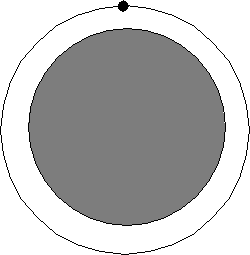 |
| e.g for the earth in orbit around the sun, we need to consider the earth as a point with some mass |  |
Note that these models for the earth are not only different, they are not even consistent! The earth cannot be an infinite flat plane, a sphere and a point at the same time!
What is an electron?
e.g
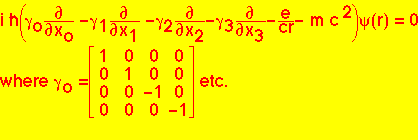
| But for a model of an electron:: A model is a spinning ball of negative charge | 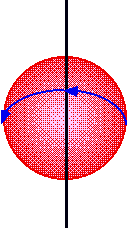 |
Note: this is not reality, but a convenient crutch for thinking!!!!
Measurements originally defined for trade e.g.
Unification of measurements possible when it was realised that (e.g.) length and area are related
| Hence 1 acre = 1 furlong x 1chain (!). It also happens to be the area that a man can easily plough in a day | 
|
Unification of measurements Then need smaller units 1 rod/pole/perch = 1/4 chain = 5 1/2 yards (!!) Then rationalise: Define
| Unit | Abbreviation | Defined by |
| 1 metre | 1 m | 1/40,000,000 th of circumference of the earth |
| 1 second | 1 s | 1/84,600 th of mean solar day |
| 1 kilogram | 1 kg | Mass of lump of platinum in Paris |
| Name | S.I. | c.g.s. | F.P.S |
| Mass | kilogram (kg) | gram (g) | slug ("pound" is a force) |
| Length | metre (m) | centimetre (cm) | foot (ft) |
| Time | second (s) | second (s) | second (s) |
| Temperature | 0Kelvin (K) | 0Celsius (0C) | 0Farenheit (0F) |
| Charge | Ampere (A) | - | - |
| Important | Factor | Name | Symbol | Factor | Name | Symbol |
|---|---|---|---|---|---|---|
| 101 | deka | da | 10-1 | deci | d | |
| 102 | hecto | h | 10-2 | centi | c | |
| * | 103 | kilo | k | 10-3 | milli | m |
| * | 106 | mega | M | 10-6 | micro | µ |
| * | 109 | giga | G | 10-9 | nano | n |
| * | 1012 | tera | T | 10-12 | pico | p |
| * | 1015 | peta | P | 10-15 | femto | f |
| 1018 | exa | E | 10-18 | atto | a | |
| 1021 | zetta | Z | 10-21 | zepto | z | |
| 1024 | yotta | Y | 10-24 | yocto | y |
e.g. A car travels 2 km at 47 km/hr. How long does it take?
t = 2/47*60 = 2.553191489 mins = 153.1914894 s
(no, its not a foreign decoration)
Very often want to be able to guess an answer before we do a detailed calculation. e.g.
What is the approximate volume of a drop of water?
Always check that units are correct at the end of a calculation.
Never substitute numbers into formula until the last step.
Can also use this to guess formulae sometimes e.g a body falls under gravity: how fast is it going after falling s feet?
Dimensions
|
[v] = [g ] [s] -⇒ LT-1 = L T-2. L = L2T-2 |
[v] = ([g ] [s])1/2 ⇒
LT-1 = (L T-2. L)1/2
= LT-1
v = 2(g s)1/2
How long does a pendulum take to swing? A pendulum consists of a weight on a string of length l, and mass M. There is an acceleration due to gravity given by g. (Acceleration has units of Length/Time2 or LT-2). Which of the following expressions could be correct for the time it takes to swing?